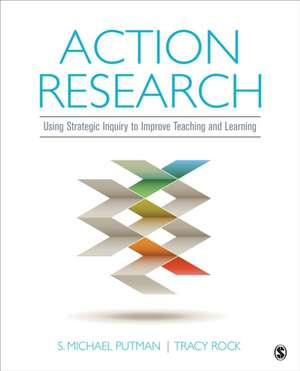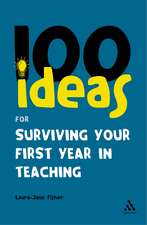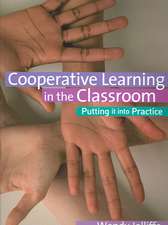Action Research: Using Strategic Inquiry to Improve Teaching and Learning
Autor S. Michael Putman, Tracy C. Rocken Limba Engleză Paperback – 27 mar 2017
- a chapter focused on collaborative action research for larger groups
- Case in Point examples from the perspective of two teachers
- Voices from the Field convey teachers' experiences conducting action research
- “Note”-able Thoughts represent a way to encourage the reader to stop and think about how the content relates to prior knowledge or experience.
- TECH Connections highlight ways that technology can be used to facilitate the research process.
Preț: 519.14 lei
Preț vechi: 701.54 lei
-26% Nou
Puncte Express: 779
Preț estimativ în valută:
99.35€ • 102.94$ • 82.91£
99.35€ • 102.94$ • 82.91£
Carte disponibilă
Livrare economică 28 februarie-14 martie
Livrare express 13-19 februarie pentru 33.76 lei
Preluare comenzi: 021 569.72.76
Specificații
ISBN-13: 9781506307985
ISBN-10: 1506307981
Pagini: 288
Dimensiuni: 187 x 232 x 15 mm
Greutate: 0.61 kg
Ediția:1
Editura: SAGE Publications
Colecția Sage Publications, Inc
Locul publicării:Thousand Oaks, United States
ISBN-10: 1506307981
Pagini: 288
Dimensiuni: 187 x 232 x 15 mm
Greutate: 0.61 kg
Ediția:1
Editura: SAGE Publications
Colecția Sage Publications, Inc
Locul publicării:Thousand Oaks, United States
Cuprins
PREFACE
Acknowledgments
ABOUT THE AUTHORS
PHASE I—TASK DEFINITION
CHAPTER 1: WHAT IS ACTION RESEARCH?
Guiding Questions
Chapter Aims and Goals
Setting the Context: Research in the Age of Accountability
Taking Action: Using the CAPES Framework
Summary
Key Terms
Case in Point: Introducing the Research Log
Activities and Additional Resources
PHASE II—GOAL SETTING AND PLANNING
CHAPTER 2: IDENTIFYING A RESEARCH TOPIC
Guiding Questions
Chapter Aims and Goals
Setting the Context: Choosing a Research Topic
Taking Action: Developing the Research Topic
Developing a Plan or a Product: Completing a Topic Proposal Form
Evaluating Against the Standards: Are You Ready to Move On?
Summary
Key Terms
Case in Point: Developing a Topic
Activities and Additional Resources
CHAPTER 3: CREATING A REVIEW OF LITERATURE
Guiding Questions
Chapter Aims and Goals
Setting the Context: Sources of Information
Taking Action: Locating and Synthesizing Information
Developing a Plan or a Product: Writing the Synthesis of Literature
Evaluating Against the Standards: Are You Ready to Move On?
Summary
Key Terms
Case in Point: Annotated Bibliography Entries
Activities and Additional Resources
CHAPTER 4: CREATING A RESEARCH PLAN
Guiding Questions
Chapter Aims and Goals
Setting the Context: Examining Characteristics and Components of Research Methods
Taking Action: Developing a Preliminary Research Plan
Developing a Plan or a Product: Initiating the Research Plan Proposal Form
Evaluating Against the Standards: Are You Ready to Move On?
Summary
Key Terms
Case in Point: Research Plan (Pre-implementation)
Activities and Additional Resources
CHAPTER 5: METHODS OF DATA COLLECTION
Guiding Questions
Chapter Aims and Goals
Setting the Context: Choosing Data Collection Methods
Validity and Reliability
Sources of Data
Taking Action: Selecting Data Collection Methods
Developing a Plan or a Product: Revising the Research Plan Proposal Form and Creating a Timeline
Evaluating Against the Standards: Are You Ready to Move On?
Summary
Key Terms
Case in Point: Revising the Research Plan and Timeline
Activities and Additional Resources
PHASE III—ENACTING
CHAPTER 6: ANALYZING THE DATA
Guiding Questions
Chapter Aims and Goals
Setting the Context: Analyzing Your Data
Taking Action: Selecting the Method of Data Analysis
Developing a Plan or a Product: Completing the Research Plan Proposal Form and Timeline
Evaluating Against the Standards: Are You Ready to Move On?
Summary
Key Terms
Case in Point: Final Research Plan and Timeline
Activities and Additional Resources
PHASE IV—ADAPTATION
CHAPTER 7: REFLECTING ON RESULTS AND PLANNING FOR ACTION
Guiding Questions
Chapter Aims and Goals
Setting the Context: Reflecting on the Results of Action Research
Taking Action: Creating a Plan for Action
Developing a Plan or a Product: Completing a Plan of Action
Evaluating Against the Standards: Are You Ready to Move On?
Summary
Key Terms
Case in Point: Reflecting on Results
Activities and Additional Resources
CHAPTER 8: THE ACTION RESEARCH REPORT: SHARING RESULTS
Guiding Questions
Chapter Aims and Goals
Setting the Context: Determining the Audience, Format, and Outlet
Taking Action: Crafting the Abstract and Policy Implication Statements
Developing a Product: Creating the Action Research Report Outline, Presentation, and Summary
Evaluating Against the Standards: Are You Ready to Move On?
Moving Forward: Potential Challenges
Summary
Key Terms
Case in Point: Action Research Summary
Activities and Additional Resources
CHAPTER 9: LEADING A COLLABORATIVE ACTION RESEARCH TEAM
Guiding Questions
Chapter Aims and Goals
Setting the Context: Organizing for Collaborative Action Research
Taking Action: Collaborative Action Research
Developing the Product: Forming the Collaborative Action Research Team
Summary
Key Terms
Case in Point: Developing a Collaborative Action Research Study
Activities and Additional Resources
APPENDIX A: EXAMPLES OF ACTION RESEARCH REPORTS
Examining the Impact of Readers’ Theater on Struggling Readers’ Fluency Levels
Using an Investigation Model in Ninth-Grade Science Class: Impact on Lower-Level Readers
APPENDIX B: POTENTIAL PUBLICATION OUTLETS FOR ACTION RESEARCH
GLOSSARY
INDEX
Acknowledgments
ABOUT THE AUTHORS
PHASE I—TASK DEFINITION
CHAPTER 1: WHAT IS ACTION RESEARCH?
Guiding Questions
Chapter Aims and Goals
Setting the Context: Research in the Age of Accountability
Taking Action: Using the CAPES Framework
Summary
Key Terms
Case in Point: Introducing the Research Log
Activities and Additional Resources
PHASE II—GOAL SETTING AND PLANNING
CHAPTER 2: IDENTIFYING A RESEARCH TOPIC
Guiding Questions
Chapter Aims and Goals
Setting the Context: Choosing a Research Topic
Taking Action: Developing the Research Topic
Developing a Plan or a Product: Completing a Topic Proposal Form
Evaluating Against the Standards: Are You Ready to Move On?
Summary
Key Terms
Case in Point: Developing a Topic
Activities and Additional Resources
CHAPTER 3: CREATING A REVIEW OF LITERATURE
Guiding Questions
Chapter Aims and Goals
Setting the Context: Sources of Information
Taking Action: Locating and Synthesizing Information
Developing a Plan or a Product: Writing the Synthesis of Literature
Evaluating Against the Standards: Are You Ready to Move On?
Summary
Key Terms
Case in Point: Annotated Bibliography Entries
Activities and Additional Resources
CHAPTER 4: CREATING A RESEARCH PLAN
Guiding Questions
Chapter Aims and Goals
Setting the Context: Examining Characteristics and Components of Research Methods
Taking Action: Developing a Preliminary Research Plan
Developing a Plan or a Product: Initiating the Research Plan Proposal Form
Evaluating Against the Standards: Are You Ready to Move On?
Summary
Key Terms
Case in Point: Research Plan (Pre-implementation)
Activities and Additional Resources
CHAPTER 5: METHODS OF DATA COLLECTION
Guiding Questions
Chapter Aims and Goals
Setting the Context: Choosing Data Collection Methods
Validity and Reliability
Sources of Data
Taking Action: Selecting Data Collection Methods
Developing a Plan or a Product: Revising the Research Plan Proposal Form and Creating a Timeline
Evaluating Against the Standards: Are You Ready to Move On?
Summary
Key Terms
Case in Point: Revising the Research Plan and Timeline
Activities and Additional Resources
PHASE III—ENACTING
CHAPTER 6: ANALYZING THE DATA
Guiding Questions
Chapter Aims and Goals
Setting the Context: Analyzing Your Data
Taking Action: Selecting the Method of Data Analysis
Developing a Plan or a Product: Completing the Research Plan Proposal Form and Timeline
Evaluating Against the Standards: Are You Ready to Move On?
Summary
Key Terms
Case in Point: Final Research Plan and Timeline
Activities and Additional Resources
PHASE IV—ADAPTATION
CHAPTER 7: REFLECTING ON RESULTS AND PLANNING FOR ACTION
Guiding Questions
Chapter Aims and Goals
Setting the Context: Reflecting on the Results of Action Research
Taking Action: Creating a Plan for Action
Developing a Plan or a Product: Completing a Plan of Action
Evaluating Against the Standards: Are You Ready to Move On?
Summary
Key Terms
Case in Point: Reflecting on Results
Activities and Additional Resources
CHAPTER 8: THE ACTION RESEARCH REPORT: SHARING RESULTS
Guiding Questions
Chapter Aims and Goals
Setting the Context: Determining the Audience, Format, and Outlet
Taking Action: Crafting the Abstract and Policy Implication Statements
Developing a Product: Creating the Action Research Report Outline, Presentation, and Summary
Evaluating Against the Standards: Are You Ready to Move On?
Moving Forward: Potential Challenges
Summary
Key Terms
Case in Point: Action Research Summary
Activities and Additional Resources
CHAPTER 9: LEADING A COLLABORATIVE ACTION RESEARCH TEAM
Guiding Questions
Chapter Aims and Goals
Setting the Context: Organizing for Collaborative Action Research
Taking Action: Collaborative Action Research
Developing the Product: Forming the Collaborative Action Research Team
Summary
Key Terms
Case in Point: Developing a Collaborative Action Research Study
Activities and Additional Resources
APPENDIX A: EXAMPLES OF ACTION RESEARCH REPORTS
Examining the Impact of Readers’ Theater on Struggling Readers’ Fluency Levels
Using an Investigation Model in Ninth-Grade Science Class: Impact on Lower-Level Readers
APPENDIX B: POTENTIAL PUBLICATION OUTLETS FOR ACTION RESEARCH
GLOSSARY
INDEX
Descriere
This text helps educators think about assessment to guide decision-making and help them be proactive in planning interventions that can be used to determine the effectiveness of various instructional strategies.








